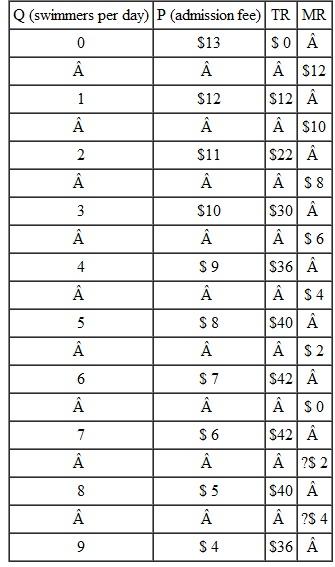
Microeconomics 6th Edition by Robert Hall, Shirley Kuiper, Marc Lieberman
Edition 6ISBN: 978-1133708735
Microeconomics 6th Edition by Robert Hall, Shirley Kuiper, Marc Lieberman
Edition 6ISBN: 978-1133708735 Exercise 2
Suppose that Patty's Pool has the demand data given in Table 1 in the chapter. Further,suppose that Patty has just two types of costs: (1)rent of $25 per day and (2)towel service costs equal to 50 cents per swimmer. Over the short run,rent is a fixed cost (Patty has a lease she can't get out of),but towel service is a variable cost (it varies with the number of swimmers). Patty's marginal cost is therefore constant at 50 cents.
a. Under these cost conditions,what are Patty's short-run profit-maximizing output and price? What is her profit or loss per day?
b. Now suppose that,in addition to the costs just described,the town imposes a "swimming excise tax" on Patty's Pool equal to $2 per swimmer. What are Patty's new short-run profit-maximizing output and price? What is her new profit per day? (Hint: First decide whether or not the excise tax affects Patty's marginal cost.)c. In addition to the costs just described (including the swimming excise tax of $2 per swimmer),suppose the town imposes a "fixed swimming tax" requiring Patty to pay $2 per day for operating her pool,regardless of the number of swimmers. What are Patty's new short-run profit- maximizing output and price? What is her new profit per day? (Hint: First decide whether or not this new fixed swimming tax affects Patty's marginal cost.)d. Now suppose that costs are as in (c),except that the fixed swimming tax is $5 per day instead of $2 per day. What are Patty's new short-run profit- maximizing output and price? What is her new profit per day?
e. With the $5 per day fixed swimming tax,what should Patty do in the short run? If Patty's longrun costs are the same as her short-run costs,what should she do in the long run? (Hint: Think about shutdown for short run; exit for long run.)f. Based on your answers to b,c,d,and e,assess the following statement: "When an excise (variable)tax is imposed on a monopoly,it will pass part,but not all,of the tax on to consumers in the form of a higher price. But a fixed tax has no effect on monopoly behavior over any time horizon." Are both of these sentences true? Explain briefly.
Table 1 Demand and Revenue at Patty's Pool

a. Under these cost conditions,what are Patty's short-run profit-maximizing output and price? What is her profit or loss per day?
b. Now suppose that,in addition to the costs just described,the town imposes a "swimming excise tax" on Patty's Pool equal to $2 per swimmer. What are Patty's new short-run profit-maximizing output and price? What is her new profit per day? (Hint: First decide whether or not the excise tax affects Patty's marginal cost.)c. In addition to the costs just described (including the swimming excise tax of $2 per swimmer),suppose the town imposes a "fixed swimming tax" requiring Patty to pay $2 per day for operating her pool,regardless of the number of swimmers. What are Patty's new short-run profit- maximizing output and price? What is her new profit per day? (Hint: First decide whether or not this new fixed swimming tax affects Patty's marginal cost.)d. Now suppose that costs are as in (c),except that the fixed swimming tax is $5 per day instead of $2 per day. What are Patty's new short-run profit- maximizing output and price? What is her new profit per day?
e. With the $5 per day fixed swimming tax,what should Patty do in the short run? If Patty's longrun costs are the same as her short-run costs,what should she do in the long run? (Hint: Think about shutdown for short run; exit for long run.)f. Based on your answers to b,c,d,and e,assess the following statement: "When an excise (variable)tax is imposed on a monopoly,it will pass part,but not all,of the tax on to consumers in the form of a higher price. But a fixed tax has no effect on monopoly behavior over any time horizon." Are both of these sentences true? Explain briefly.
Table 1 Demand and Revenue at Patty's Pool

Explanation
a)The monopolist Patty will try to maxim...
Microeconomics 6th Edition by Robert Hall, Shirley Kuiper, Marc Lieberman
Why don’t you like this exercise?
Other Minimum 8 character and maximum 255 character
Character 255



